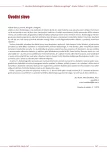Treatment of hypertension in patients with diabetes mellitus and lower limb ischemia
Authors:
M. Souček
Authors‘ workplace:
II. interní klinika Lékařské fakulty MU a FN u sv. Anny Brno, přednosta prof. MU Dr. Miroslav Souček, CSc.
Published in:
Vnitř Lék 2010; 56(4): 309-312
Category:
11th National Diabetes Symposium "Diabetes and Angiology", Hradec Kralove, 5 to 6 June 2009
Overview
he impact of some types of antihypertensives on carbohydrate metabolism and their association with type 2 diabetes is well‑known. In this respect, ACE inhibitors, AT1 blockers or I1 imidazoline agonists, known to improve insulin sensitivity, are the first line therapeutic choice. Metabolism- neutral calcium channel blockers, particularly the dihydropyridines, are the second in line of therapeutic options. On the other hand, beta‑blockers and diuretics, thiazide in particular, exert negative effect on carbohydrate metabolism. Should their use be still desirable, e. g. due to co‑ morbidities, it is advisable to select cardio‑ selective beta‑blockers or beta‑blockers with ISA activity, since the effect of these agents on carbohydrate and lipid metabolism is less significant. Diuretics should then be used only in combination therapy and in small doses; potassium‑ sparing or metabolically neutral indapamide derivatives should be selected. The benefit of cardioprotectivity, gained from the treatment with cardioselective beta‑blockers will, particularly in patients with ischemic heart disease, usually outweigh the risk of metabolic adverse effects. Combination therapy, using AT1 blockers or ACE inhibitors in combination with calcium channel blockers or diuretics, should be utilized to its full potential in order to ensure that target values are achieved. Recently completed studies provide the evidence to support this approach. Hypertension in patients with lower limb ischemia increases the already high cardiovascular risk in these patients. Blood pressure reduction as such is more important than a specific antihypertensive.
Key words:
antihypertensive treatment – diabetes mellitus – combination therapy – cardiovascular risk – lower limb ischemia
Sources
1. Arauz‑ Pacheco C, Parrott MA, Raskin P. American Diabetes Association. Hypertension management in adults with diabetes. Diabetes Care 2004; 27 (Suppl 1): S65– S67.
2. Tight blood pressure control and risk of macrovascular and microvascular complications in type 2 diabetes: UKPDS 38. UK Prospective Dibates Study Group. BMJ 1998; 317: 703– 713.
3. Mancia G, de Backer G, Dominiczak A et al. 2007 Guidelines for the management of arterial hypertension. The Task Force for the Management of Arterial Hypertension of the European Society of Hypertension (ESH) and of the European Society of Cardiology (ESC). Eur Heart J 2007; 28: 1462– 1536.
4. Zanchetti A, Grassi G, Mancia G. When should antihypertensive drug treatment be initiated and to what levels should systolic blood pressure be lower? A critical reappraisal. J Hypertens 2009; 27: 923– 934.
5. Mancia G, Laurent S, Agabiti‑ Rosei E et al. Reappraisal of European guidelines on hypertension management: a European Society of Hypertension Task Force document. J Hypertens 2009; 27: 2121– 2158.
6. Patel A, MacMahon S, Chalmers J et al. ADVANCE Collaborative Group. Effects of a fixed combination of perindopril and indapamide on macrovascular and microvascular outcomes in patients with type 2 diabetes mellitus (the ADVANCE trial): a randomised controlled trial. Lancet 2007; 370: 829– 840.
7. Jamerson K, Weber MA, Bakris GL et al. ACCOMPLISH Trial Investigators. Benazepril plus amlodipine or hydrochlorothiazide for hypertension in high‑risk patients. N Engl J Med 2008; 359: 2417– 2428.
8. Nadar S, Lim HS, Beevers DG et al. Lipid lowering in hypertension and heart protection: observation from the Anglo‑ Scandinavian Cardiac Outcomes Trial (ASCOT) and the Heart Protection Study. J Hum Hypertens 2002; 16: 815– 817.
9. Fox KM. Efficacy of perindopril in reduction of cardiovascular events among patients with stable coronary artery disease: randomised, double‑blind, placebo controlled, multicentre trial (the EUROPA study). Lancet 2003; 362: 782– 788.
10. Gerstein HC, Miller ME, Byington RP et al. Action to Control Cardiovascular risk in Diabetes Study Group. Effects of intensive glucose lowering in type 2 diabetes. N Engl J Med 2008; 358: 2545– 2559.
11. Gaede P, Lund‑ Andersen H, Parving HH et al. Effect of a multifactorial intervention on mortality in type 2 diabetes. N Engl J Med 2008; 358: 580– 591.
12. Holmann RR, Paul SK, Bethel MA et al. 10‑years follow‑up of intensive glucose control in type 2 diabetes. N Engl J Med 2008; 359: 1577– 1589.
13. Zanchetti A, Bond MG, Henning M et al. European Lacidipine Study on Atherosclerosis investigators. Calcium antagonist lacidipine slows down progression of asymptomatic carotid atherosclerosis: principal results of the European Lacidipine Study on Atherosclerosis (ELSA), a randomized, double‑blind, long‑term trial. Circulation 2002; 106: 2422– 2427.
14. Yusuf S, Sleight P, Pogue J et al. Effects of an angiotensin‑converting enzyme inhibitor, ramipril, on cardiovascular events in high‑risk patients. The Heart Outcomes Prevention Evaluation Study Investigators. N Engl J Med 2000; 342: 145– 153.
Labels
Diabetology Endocrinology Internal medicineArticle was published in
Internal Medicine

2010 Issue 4
Most read in this issue
- Angiopathy and the eye
- Peripheral arterial disease and diabetes
- Surgical treatment of ischemic heart disease and diabetes mellitus
- Diabetes mellitus and ischemic heart disease
